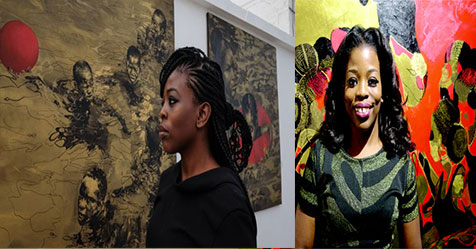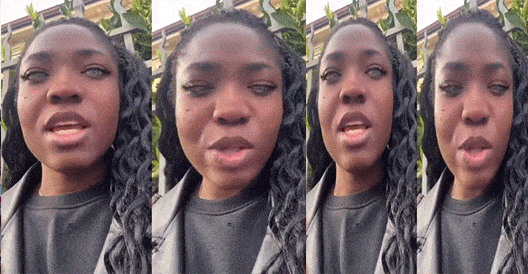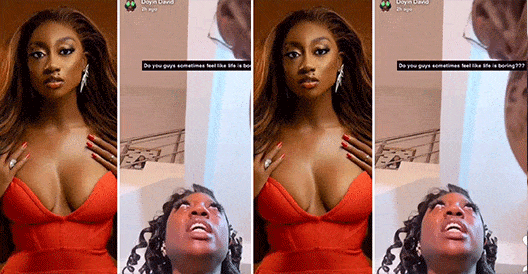Featured
Women: we are really owning our space And Our time is now

Ready for the world with a background in Chemical engineering, economics, and education, and working at the nexus of science, politics, and art, Modupeola Fadugba is a multi-media artist working in painting, drawing, and socially-engaged installation. She works in series addressing cultural identity, social justice, game theory, and the art world within the socio-political landscape of Nigeria and our greater global economy. Modupeola Fadugba Fadugba believes that women are already playing a major role in building a creative, curatorial and commercial structure in the art world. Her recent work includes Design is the Personality of an Idea (Ford Foundation & African Artists Foundation, Lagos, 2015). Fadugba’s recently innovated interactive game installation, the People’s Algorithm was awarded El Anatsui’s Outstanding Production Prize (2014) and a 2016 Dakar Biennale Grand Prize from Senegal’s Minister of Communication. She also has works in the collections of The University of Delaware, the Sindika Dokolo Foundation and Liberian President, Ellen Johnson Sirleaf. Exerpts Studying in the United States and other countries has given you the opportunity to compare and contrast. What are the major obstacles hindering women’s education in Africa? My education spanned four countries and three university degrees. I have always known this was a result of incredible luck. Working in education in Nigeria, I saw just how stark the other possibilities are. There are 10.5 million children out of school, 20 million unemployed young people and interminable university strikes. In certain parts of the country, the girls and women fare worse than their male counterparts, but more generally, issues of quality and access to education in Nigeria can’t be overstated. What role do you want women to be playing in Africa that they have not delved into in the past? I think women are already playing a major role in building a creative, curatorial and commercial structure in the art world. On the continent, we have a number of premier research institutions, galleries, incubators and international art fairs, all run by vision-driven African women. I also find that women artists continue to blaze the trail for Contemporary African Art. We’ve spent a long time catching up, but it does feel like our time is now and we are really owning our space. In what way has your paintings, teachings & game innovations transformed the lives of women? It might be presumptuous or premature to suggest that my works are directly transforming the lives of women. Art is meant to inspire. And transformation requires much more than inspiration, though it can serve as an ignition. I do hope that my works can ignite meaningful discussions, a new way of seeing things -for all- not just women. With your art work placed in front of your Chemical Engineering Department in the University of Delware in the United States, how does it feel? The artwork, titled, “Beyond the Blackboard” depicts a young African girl-child collecting water into a calabash on her head, from a distillation column, hinting at linkages between the practical and the scientific, the academic and the essential. I created the work for the University of Delaware almost 10 years ago and it was the first and only time the Chemical Engineering Department would commission such an artwork. It feels special on several fronts and I’m honoured that my work has a permanent home at my alma mater. My background is so diverse that I also think it is what adds to it because like I said, I don’t know any artiste that would have studied chemical engineering, and would also go to Harvard to study education and then leaving all of that for arts. So, I think it is just the number of experiences that I have had, the number of things I’ve been exposed to have all combined to making this choice and decision and it’s all very evident and it’s not just my work but my presentation. I don’t think you can take this sort of educational experience for granted. A lecturer in that university inspired. He comes to Nigeria every year to teach at the African university of science and technology. He has been a great mentor for the past ten years but in the course of our relationship I just showed him the work that I have done and he said this is great that how come nobody knows about it and I said well, because I was studying chemical engineering and there was nothing like mixing art and chemical engineering. So I actually told him not to tell anybody but before I knew it, he had called all the teachers and persons into a meeting to say that I should do this work and they all want to support me. They commissioned me to do a piece of art in the school, so after I did, they just said ‘name your price’. So I named my price and they paid. For the past ten years, it’s been there. There is a description of the painting. It’s actually just four feet by three feet. Not even as big as all this work I’m doing now but it’s unique. And it’s quite a powerful message. I worked on it for almost five months. Is it African art or what? It’s created with my own length if you can picture it: there is a small child, a small African girl, she is black so you also know that there is this influence even as a white person because it is mostly white men that study chemical engineering. Even if you walk into the building and you see this, you would know that it’s probably someone from Africa that did this because the face represented there is that of a small African child or a black child and she has a calabash on her head. In many ways it is very much a typical African art but with that calabash, she was collecting water in the calabash. So it’s also linking to chemical engineering concept and also concept of development. What does it mean for children to have water, to have education, to have the basic needs? It’s all full circle and I am happy it’s there. What is your advice for upcoming female artists/entrepreneurs who wish to become successful in doing what they love? Artists and entrepreneurs share similar traits; they seek to create value and are relentless problem solvers. These mandates don’t come with blueprints, so the artist/entrepreneur must be ever-learning, ever-adapting, highly self-motivated and willing to collaborate wisely. If you are doing it right, you will be exhausted. But if you love it, you will find the strength to continue. Keep your head up and keep swimming! When I studied education I was very passionate about education and making a difference in the education sector in Nigeria so I did that by working as the director of student affairs at the University in Abuja. I also did monitoring and evaluation for girls project teaching young girls about business skills. These are marginalized girls; they otherwise don’t have many options in life. I did that as a job but you just found out that the impact is different. I found that my voice is much stronger and I had a better platform and I had more reach as an artiste. I’ve found that the way people have responded to me is also evidence that this is the best platform for me. When you take your art outside Nigeria, does it speak more of local art or international art? I think it has international appeal but I am also still looking at local subjects in the country. Local content? Local content I mean the people that think like me so if they take it to Japan they will know this person is an African artist What kind of innovations are you bringing to the world? My game installation. Have you heard of the people algorithm? That is a game I created called the people algorithm and you can check it out on my web site. There is actually good content and video that describes it. But it is completely different from what you see here today. It’s a game like a big box that you walk in and it describes the education system in Nigeria so you have a dice, you are rolling dice, it’s like monopoly and you play. Let’s say you are a student and you roll the dice and something happens to you. Let’s say your university is on strike so the game would tell you please take three steps back or as a teacher you roll the dice and it would say that government is delaying on salary payment so for eight months and you have not been paid. Take four steps back. These are real life scenarios. So I think when you play it as a game, you realise that this is just a gamble because while you have to be lucky to succeed in education system, why can’t you just have the system that works that supports students and supports the teachers that doesn’t go and put unnecessary delay in their life. Because as it is now, people go to the university understanding that the system is going to delay their life so you take three years from somebody life, what type of potential do you want them to realise and when you do this to everybody and make them accept it as normal? It’s wrong. What is the drive for the painting of the late Dr. Stella Adadevoh, the ebola saviour in Nigeria? I think she essentially saved our country from doom. If she had not caught ebola in the time that she did, in the way that she did it, it would have been a national catastrophe for us. And you know we Nigerians travel a lot. One day Kano, next day Kaduna, next day London, next day Paris. So I don’t even think it would have been a national catastrophe only, it would have been a global one. I think she deserves to be honoured. If we are printing more money in Nigeria it needs to be her head that is there. It is just very symbolic, not even because she is a woman because if she was a man I would have painted him as well. We just have to give honour to whom it is due.




